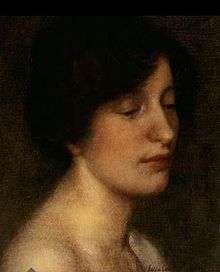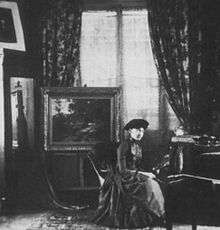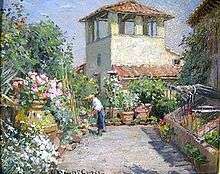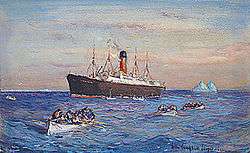Emma Lampert Cooper
Emma Lampert Cooper (February 24, 1855 – July 30, 1920) was a painter from Rochester, New York, described as "a painter of exceptional ability".[1] She studied in Rochester, New York; New York City under William Merritt Chase, Paris at the Académie Delécluse and in the Netherlands under Hein Kever. Cooper won awards at several World's Expositions, taught art and was an art director. She met her husband, Colin Campbell Cooper in the Netherlands and the two traveled, painted and exhibited their works together.
Emma Lampert Cooper | |
|---|---|
 Portrait of Emma Lampert Cooper by Colin Campbell Cooper | |
| Born | Emma Esther Lampert February 24, 1855 |
| Died | June 30, 1920 (aged 65) |
| Nationality | American |
| Education | Art Students League |
| Known for | Painting |
| Movement | Realism |
| Spouse(s) | Colin Campbell Cooper (m. 1897) |
| Awards | |


%2C_Spring_Landscape%2C_water_color.jpg)
Early life
Emma Esther Lampert was born in Nunda, New York on February 24, 1855,[2][3] to Henry and Jenette (Smith) Lampert.[4] That year her father – born in Hanover, Germany – was a tanner and two other German tanners and a servant were living in the house with the family. Emma had an older sister name Mary, younger sisters Carrie and Adella, and a younger brother named Henry. The family lived in Rochester, New York and her father was a leather wholesaler by 1870.[5][6] Her father registered for the draft for the American Civil War in June 1863. He died June 10, 1880.[7][8]
Career
Education and early career
She graduated from Wells College in Aurora, New York, in 1875.[4][9] Cooper was a founding member of the Eastern Association of Wells College alumni.[9]
In 1877, the Rochester Art Club was formed, and Cooper was its first vice president, marking the beginning of a long relationship with the Club. She held the positions of vice president, secretary and president and was a member until 1895. From 1870 to 1886 Cooper had a studio in the historic Powers Building in Rochester, New York.[4] Within Rochester, she had a "notable influence" on the city's art community.[2]
She returned to New York City to study at the Art Students League and Cooper Union, and she studied under William Merritt Chase.[2][4][9] Cooper studied in Paris at the Académie Delécluse for 18 months in the mid-1880s[2][4] and under Hein Kever in the Netherlands in 1891.[3][4]
Educator
From 1891 to 1893 Cooper taught painting and was the art director at the Foster School in Clifton Springs, New York,[9] which was open between 1876 and 1885.[10] From 1893 through 1897, Cooper taught at the Mechanics Institute, now the Rochester Institute of Technology.[4][9]
Marriage
In 1897, while working and living in Dordrecht, she met painter Colin Campbell Cooper. They married on June 9, 1897 in Rochester, New York. The couple traveled abroad between 1898 and 1902, living in the Laren artist colony in the Netherlands for one year. Then, they primarily lived in New York City, and also traveled extensively, to Europe and her hometown, Rochester.[11] They were in India in 1913, reputedly both having been commissioned by a patroness from the United States to make paintings. The works from that trip were exhibited in Rochester, New York in 1915.[12] Because of her work in the United States and abroad, she was considered knowledgeable of the international art community.[2]
Art works and exhibitions
Her subjects were primarily still lifes and landscapes from her travels. She closed her Rochester studio in 1886 and traveled to Paris.[4] In 1887 she exhibited Hillside at Picardy at the Paris Salon. For her painting Breadwinner, Cooper was given an award at the Chicago's World's Fair in 1893[9][13] and the Cotton States and International Exposition in Atlanta in 1895.[9] Cooper was awarded a gold medal at the 1902 American Art Society exhibition in Philadelphia.[4] She exhibited oil and watercolor paintings at the St. Louis World's Fair of 1904 and won a bronze medal for a Weaving Homespun[14] and another bronze medal.[4][9] Her works were exhibited at the Paris Exposition of 1900.[9][15] Cooper's paintings were exhibited with her husband' in shows in Rochester, Chicago, New York and Philadelphia, and Buffalo between 1902 and 1910.[16] In 1915 she showed paintings of India alongside works by Alice Schille, Adelaide Deming and Helen Watson Phelps in New York.[17]
"Floral Femininity: A Pictorial Definition"[18]


Cooper became an artist during the 19th century when there was a significant number of women who became successful, educated artists, a rarity before that time, except for a few like Angelica Kauffman and Louise Élisabeth Vigée Le Brun (1755–1842).[19] The emerging women artists created works with a different perspective than men, challenged the limited concepts of femininity and created a genre of floral-female landscape paintings, in which "the artist placed one woman or more in a flower garden setting and manipulated composition, color, texture and form to make the women look as much like flowers as possible." These artists were among the educated, sophisticated "New Women" beginning in the late 19th century, whose influence was largely ignored by art scholars.[18]
Cooper was one of the well-educated artists who became a successful landscape painter and academic figure who began as a children's book illustrator and painter of miniatures and flower paintings. Realizing the difficulty in making the transition to a successful painter, particularly of landscape and figure paintings, Cooper warned other women artists of the difficulty in creating a successful career in such works. She, however, was able to overcome the obstacles and become a successful landscape artist.[19]
Cooper was a member of the Women's International Art Club in London, Pennsylvania Academy of Fine Arts and the Women's Art Association of Canada. In New York, she was a member of Woman's Art Club, National Arts Club, and the New York Watercolor Club.[4][9] She was a charter member of the Rochester Art Club and the Philadelphia Water Color Club.[4]
Collections
Cooper's paintings are held in private and public collections, including the Memorial Art Gallery of the University of Rochester;[20] Strong Museum in Rochester, New York;[21] Weatherspoon Art Museum in Greensboro, North Carolina;[22] and Wells College in Aurora, New York.[23]
Carpathia
The couple was among the first class passengers on the Cunard liner RMS Carpathia en route from New York to Gibraltar in April 1912, when it picked up the survivors of the RMS Titanic.[24][25][26] They aided in the rescue of survivors[27] and shared their room and took care of survivor Irene Harris, the wife of theatre manager Henry B. Harris, who had perished in the sinking.[28] Colin Campbell Cooper subsequently made several paintings of the Titanic.[27]
 Colin Campbell Cooper, Rescue of the Survivors of the Titanic by the Carpathia, 1912, Midwest Museum of Art
Colin Campbell Cooper, Rescue of the Survivors of the Titanic by the Carpathia, 1912, Midwest Museum of Art
Death
She died in 1920[29] at home of her sister, Mrs. John Steele[30] in Pittsford, New York on July 30. She is buried in Mount Hope Cemetery in Rochester, New York.[4]
In January 1940, a retrospective exhibition of her works was held at George H. Brodhead Fine Arts in Rochester.[4] Her and her husband's papers are held in the manuscript collection of the River Campus Libraries at the University of Rochester.[31]
Works
Europe or North America
- A Corner in the Studio, oil, 1882–1897[32]
- A Dutch Cavalier, water color, Memorial Art Gallery, University of Rochester[33]
- Adobe House, oil, c. 1900, private collection[32]
- An Old Mill, Holland, water color, 1897–1917[32]
- At Colorado Springs, Colorado, oil, at "Cragsmoor Artist's Vision of Nature" exhibition, Cragsmoor Free Library, New York in 1977[32]
- Bee Hives in a French Garden, drawing, 1888, Memorial Art Gallery, University of Rochester[33]
- Behind the Dunes[13]
- Brittany Farmyard, oil, 1882–1897[32]
- Canal in Holland, water color, c. 1885–1897[32]
- Cape Cod Vista, oil, Memorial Art Museum, University of Rochester[32]
- Courtyard, oil, private owner[34]
- Crooked Houses, oil, c. 1897–1910[32]
- Dutch Interior, oil, 1882–1897[32]
- Geranium, oil[32]
- Gray Day, oil, 1882–1897[32]
- Gray Day, Mystic, Connecticut, oil, 1882–1897[32]
- Hillside in Picardy[13]
- Landscape, Autumn, water color, c. 1897–1920[32]
- Landscape, France, oil, 1882–1897[32]
- Life Work, oil, labor interior scene, Weatherspoon Art Museum, Greensboro, North Carolina[32]
- Little Shop, oil, c. 1900[32]
- Little Shop, Holland, oil, at "A Century of women artists in Cragsmoor: original works by women artists who have created in Cragsmoor during the past 100 years," Cragsmoor, N.Y.: Cragsmoor Free Library, 1979[32]
- Morning Near Riverdale, oil, c. 1885, Wells College, Aurora, New York[32]
- New England Vista, oil, Memorial Art Gallery, University of Rochester[32]
- Old Well, Pittfield, New York, water color, c. 1885–1897, Strong Museum, One Manhattan Square, Rochester, New York [32]
- On a French River, painting, Memorial Art Gallery, University of Rochester[33]
- Rose Covered Verandah, oil, 1897–1920[32]
- Roses – still life, oil, in 1987 at Lagakos-Turak Gallery, Philadelphia[32]
- San Diego Exposition 1916, oil, interior scene, private collection[32]
- Side Door of a Manor House, Touraine, oil, 1897–1920[32]
- Spurting Rock, water color, 1885–1897[32]
- Still Life, water color, 1897–1920[32]
- The Breadwinner, water color, 1891, Memorial Art Gallery, University of Rochester[32][33]
- The Farm House, water color, c. 1885–1897[32]
- The Marsh, oil[32]
- Through the Meadows in Holland[13]
- Untitled (landscape with bridge), painting, Memorial Art Gallery, University of Rochester[33]
- Weaving Homespun, Canada, oil, c. 1904, Memorial Art Gallery, University of Rochester[32][33]
- Wheelwright at Work, oil, figure drawing, c. 1880[32]
- Wheelwright at Work, oil, interior scene, c. 1880[32]
- Windmills, oil, 1897–1920[32]
- Young Boys in Landscape, oil, in 1987 at Lagakos-Turak Gallery, Philadelphia[32]
India
Works made in India in 1913 and exhibited in the Memorial Art Gallery in Rochester and Milwaukee in 1915 include:[35][36]
- Bazaar at Little Agra
- Bombay Street
- Candy bazaar, Agra
- Ceylon House Servant
- Chauk bazaar, Lucknow
- Delhi Fruit Stand
- Dye house at Udaipur
- Entrance to a Temple, Jaipur
- Holy Man's Tomb at Agra, oil, c. 1895, Wells College, Aurora, New York[32]
- Leogryphs, Rangood, Burma, water color
- Native quarter, Bombay, water color
- Snake charmer
- Street corner, Udaipur
- Street of dye houses, Little Agra
- Temple at Little Agra
- Tomb at Agra, water color
- Water carrier
References
- William H. Gerdts. East Coast/West Coast and Beyond: Colin Campbell Cooper, American Impressionist. Hudson Hills; 2006. ISBN 978-1-55595-269-3., p. 13
- Richard H. Love; Carl William Peters. Carl W. Peters: American Scene Painter from Rochester to Rockport. University Rochester Press; 1 January 1999. ISBN 978-1-58046-024-8. p. 91
- Emma E. Lampert record, passport issued July 3, 1891. National Archives and Records Administration (NARA); Washington D.C.; Passport Applications, 1795–1905; Collection Number: ARC Identifier 566612 / MLR Number A1 508; NARA Series: M1372; Roll #: 377.
- Rochester Art Club. Biographies of Founders. Archived 2013-09-09 at the Wayback Machine Rochester Art Club. Retrieved February 7, 2014.
- Emma E. Lampert record, 1855 New York state census. Nunda Village, Livingston, New York. Census of the state of New York, for 1855. Microfilm. New York State Archives, Albany, New York.
- Emma E. Lampert record, 1870 federal census. 1870 U.S. census, population schedules. NARA microfilm publication M593, 1,761 rolls. Washington, D.C.: National Archives and Records Administration, n.d.
- Henry Lampert record, Sons of the American Revolution Membership Applications, 1889–1970. Louisville, Kentucky: National Society of the Sons of the American Revolution. Microfilm, 508 rolls.
- Henry Lampert record, National Archives and Records Administration (NARA); Washington, D.C.; Consolidated Lists of Civil War Draft Registration Records (Provost Marshal General's Bureau; Consolidated Enrollment Lists, 1863–1865); Record Group: 110, Records of the Provost Marshal General's Bureau (Civil War); Collection Name: Consolidated Enrollment Lists, 1863–1865 (Civil War Union Draft Records); ARC Identifier: 4213514; Archive Volume Number: 3 of 7.
- John William Leonard; William Frederick Mohr; Frank R. Holmes. Who's who in New York City and State. L.R. Hamersly Company; 1907. p. 329
- Historic Timeline of Clifton Springs, New York. Archived 2014-02-22 at the Wayback Machine Foster Cottage Museum.
- William H. Gerdts. East Coast/West Coast and Beyond: Colin Campbell Cooper, American Impressionist. Hudson Hills; 2006. ISBN 978-1-55595-269-3., pp. 18, 54, 58
- William H. Gerdts. East Coast/West Coast and Beyond: Colin Campbell Cooper, American Impressionist. Hudson Hills; 2006. ISBN 978-1-55595-269-3. p. 71, 130
- Richard H. Love; Carl William Peters. Carl W. Peters: American Scene Painter from Rochester to Rockport. University Rochester Press; 1 January 1999. ISBN 978-1-58046-024-8. p. 101
- James H. Lambert, Pennsylvania, Louisiana Purchase Exposition Commission. The story of Pennsylvania at the World's Fair St. Louis, 1904. The Pennsylvania Commission; 1905. p. 57, 335, 336.
- Richard H. Love; Carl William Peters. Carl W. Peters: American Scene Painter from Rochester to Rockport. University Rochester Press; 1 January 1999. ISBN 978-1-58046-024-8. p. 111-112
- William H. Gerdts. East Coast/West Coast and Beyond: Colin Campbell Cooper, American Impressionist. Hudson Hills; 2006. ISBN 978-1-55595-269-3. p. 62
- "Group exhibition of recent paintings by Helen Watson Phelps, Alice Schille, Adelaide Deming and Emma Lampert Cooper [electronic resource] : pictures of India, Mar. 1–13, 1915". Internet Archive. Retrieved 4 March 2016.
- Annette Stott. "Floral Femininity: A Pictorial Definition". American Art. The University of Chicago Press. 6: 2 (Spring, 1992). p. 61.
- Annette Stott. "Floral Femininity: A Pictorial Definition". American Art. The University of Chicago Press. 6: 2 (Spring, 1992). p. 75.
- Memorial Art Gallery, University of Rochester.
- Gray Day, Mystic, Connecticut, (painting). Art Inventories Catalog. Smithsonian American Art Museum. Retrieve March 30, 2014.
- Life Work. Art Inventories Catalog. Smithsonian American Art Museum. Retrieve March 30, 2014.
- Holy Man's Tomb at Agra, (painting). Art Inventories Catalog. Smithsonian American Art Museum. Retrieve March 30, 2014.
- Pamela Wall, Sara Arnold. "Outside Perspectives: Visiting Artists in Charleston." Antiques & Fine Art. 11th Anniversary, 2011. p. 305 p. 305
- Colin Campbell Cooper Biography. Archived 2010-12-22 at the Wayback Machine National Museum of Wildlife Art
- Ruth Lilly Westphal, Martin E. Petersen, Janet B. Dominik. Plein Air Painters of California: The North. Irvine, CA: Westphal Publishing. 1986. ISBN 0-9610520-1-5 p. 61
- "Titanic Hero Colin Campbell Cooper, Jr." Mental Floss. March 10, 2009. Retrieved March 30, 2014.
- RMS Titanic History and Biography. Irene Harris. Encyclopedia Titanica.
- William H. Gerdts. East Coast/West Coast and Beyond: Colin Campbell Cooper, American Impressionist. Hudson Hills; 2006. ISBN 978-1-55595-269-3. p. 54
- New York Times. Emma E. Lampert obituary. August 21, 1920. New York Times.
- Emma Lampert Cooper papers, Manuscript Collection, River Campus Library, University of Rochester.
- Search: Emma Lampert Cooper. Collections Search Center. Smithsonian American Art Museum. Retrieved March 30, 2014.
- Memorial Art Gallery. Emma Lampert Cooper. Memorial Art Gallery, University of Rochester. Retrieved February 7, 2014.
- Richard H. Love; Carl William Peters. Carl W. Peters: American Scene Painter from Rochester to Rockport. University Rochester Press; 1 January 1999. ISBN 978-1-58046-024-8. p. 112
- An Exhibition of paintings made in India by Colin Campbell Cooper and Emma Lampert Cooper, a collection of paintings, miniatures, and sculpture from the Guild of Boston Artists, miniatures by Mathias Sandor the Memorial Art Gallery, Rochester, New York, October 30th to November 28th, 1915. Rochester, New York: The Gallery, 1915.
- Magazine of Art. American Federation of Arts; 1916. p. 212.
Further reading
- "Emma Lampert Cooper pages". Rare Books, Special Collections, and Preservation, River Campus Libraries, University of Rochester.